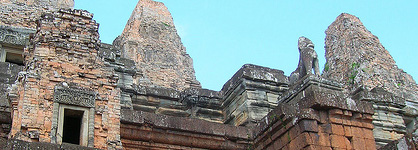Vegan and Vegetarian Food in Cambodia
Manage episode 155930274 series 1171191

Pre Rup
Bill toured the temples of Cambodia, and found a foodie Frenchman running a vegetarian restaurant.
http://www.archive.org/download/TravellingAndEatingVeganInSoutheastAsiaCambodia/seasiajourney_cambodia_v1_vbr.mp3 Download internet radio report (4 mins 53 secs): Travelling and Eating Vegan in Southeast Asia: Cambodia (MP3 3.33MB) (other sound file formats)
Download internet radio report (4 mins 53 secs): Travelling and Eating Vegan in Southeast Asia: Cambodia (MP3 3.33MB) (other sound file formats)
This is the second of three reports from Bill’s travels. Please follow these podcasts and blogs for the other two; or enjoy an episode of The Vegan Option about this Southeast Asian trip.
Bill on Cambodia
Eating on the tourist trail in Cambodia took a bit more effort. It was harder to communicate because fewer people spoke English, I had learnt even less Khmer than Thai, labels were rarely in English, and the usually useful Vegan Passport failed me in Cambodia.
This is all a little frustrating, because communication is more important in Cambodia. My guide book had already warned me that many Cambodians do not understand vegetarianism, so I wanted to be sure I was clear. Many food stalls lacked a supply of water, so street traders cannot wash pots after cooking meat, or blenders after making milkshakes, even if you could ask them to.
User Simpson Yellow added some useful phrases to the Happy Cow Cambodia notes page. Nicolas pronounced “Dtai bon-lai” (“only vegetables”) for us. If you know Khmer, and can advance our collective knowledge by confirming the information already out there and telling us how to make sure, please do add them in the comments – or better still, to the Happy Cow notes page.
(The UK vegan society would love to hear from you if you can translate the Vegan Passport text into Khmer.)
The major tourist sites have their own vegetarian restaurants. In Siem Reap, I discovered the western-style V&A and Nicolas’ Chamkar with its Khmer cooking.
My guide and translator Em was invaluable, not just for the history of the monuments I visited and communicating with restaurants, but for a window into Cambodian culture. I asked him to tune the radio into Khmer stations and explain the songs. One stuck in my memory: the singer was a bridegroom worried about his wedding night because his bride was not a virgin. Worse for the groom, the ex-boyfriend was a his best friend. Em described the conflict between the countryside that expected virgin brides and the pressure of the cities. As culture changed, Cambodian women were caught between expectations.
When I cycled around temples, I would keep myself going with snacks and fruit. The famous rule for staying healthy on local food is “peel it, boil it, cook it, or forget it” – which meant forgoing all the pre-sliced mango sold on a stick in plastic bags. I did cave in and try it when I was about to go home, and it was very tasty. Going back, I would have brought a sharper knife for peeling mango.
One of my many regrets about Cambodia is not stopping by a greengrocer stall and trying all the exotic varieties of fruit. I tried only one. It was awful. It was like eating a dry sponge. Another taste I have yet to acquire from Em is the sharp tang of unripe mango, neatly sliced with sauces.
You may wish to read other people’s experiences, such as the Vegan Undergound trip earlier this year, and the VegNews tour in 2006. Both stayed longer and went to places I did not, including the capital Phnom Penh.
My thanks go to Nicolas, Ananda (voice of the Time Out New York Kitchen Report infographic), and the Elephant Nature Park mahouts for your contributions.
![]() If you enjoyed this podcast, you can easily subscribe to future Verdant Reports podcasts here.
If you enjoyed this podcast, you can easily subscribe to future Verdant Reports podcasts here.
4 에피소드





